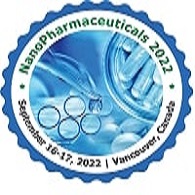
Sumaira Anjum
Kinnaird College for Women, Lahore Pakistan
Title: Light-Emitting Diodes: As External Stimulus for Plant-Mediated Biosynthesis and Biological Activities of Silver Nanoparticles
Biography
Biography: Sumaira Anjum
Abstract
The trend of using biological entities particularly plant extracts for nanoparticles (NPs) synthesis has expedited in recent years due to environmental safety, cost effectiveness, simplicity and sustainability of green route. Moreover, the morphology of NPs could be fine-tuned by applying abiotic factors such as LEDs which enhance the bio-reduction of precursor salt and excites phytochemicals during the green synthesis. Given this, in present study the green synthesis of AgNPs was carried out using by Dalbergia sissoo leaves extract under the illumination of red, green, blue, yellow and white LEDs. Phytochemical analysis revealed that D. sissoo was enriched with phenolic (23.6 ± 0.76 mg GAE/g DW) as well as flavonoids content (1.65± 0.01 mg QE/g DW) which attributed to high FRSA (80.84 ± 0.87 %). The phytochemical profile reflected upon the effective synthesis of AgNPs as alcohols and phenols were mainly involved in capping and bio-reduction revealed from FTIR analysis. Moreover, XRD analysis showed face center cubic crystalline nature of AgNPs with interesting finding that LEDs helped in reducing the size of AgNPs significantly. Y-DS-AgNPs (34.63 nm) being smallest in size as compared to control (87.35 nm). LEDs not only reduced the size of AgNPs but SEM analysis showed synthesis of non-agglomerated differently shaped AgNPs including spherical, triangular, hexagonal as compared to mixed shape control AgNPs. Theses green biocompatible AgNPs showed extraordinary therapeutic potential specially B-DS-AgNPs resulted in highest anti-oxidant (FRAP 485.6 ± 9.6 µM TEAC; CUPRAC 588.1 ± 8.4 µM TEAC; ABTS 323.4 ± 10.4 µM and ORAC 469.2 ± 11.3 µM TEAC), anti-glycation (63.3 ± 2 % and 33.1 ± 3 % inhibition of vesperlysine-like AGEs and pentosidine-like AGEs) as well as anti-bacterial activities. While Y-DS-AgNPs effectively inhibited HepG2 cells growth (cell viability 26.01 ± 1.56 %) by inducing intracellular ROS/RNS generation (3807.62 ± 236.63 relative DHR-123 fluorescence), disrupting mitochondrial membrane potential (1839.29 ± 162.45 RFU) via caspase-3 gene activation (419.15 ± 106.51 log 2-fold change) and enhanced caspase-3/7 activity (137.26 ± 41.13 RFU/mg protein). Lastly, these NPs showed mild toxicity towards brine shrimp and caused moderate hRBCs hemolysis, showing their biosafe nature which can be enhanced at lower concentrations. Here we conclude that external factors such as LEDs are effective in controlling the morphology of AgNPs which reflects upon their enhanced biological efficacy.

